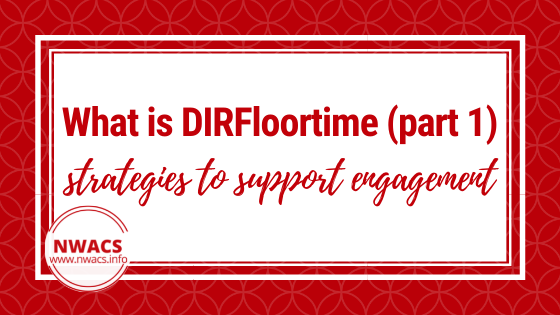by Marci Revelli, MS, CCC-SLP (Speech-Language Pathologist); NWACS Board Member
reading time: 3 minutes
The views expressed in this post are that of the author and do not necessarily reflect the views and policies of NWACS. No endorsement by NWACS is implied regarding any device, manufacturer, resource, or strategy mentioned.
What to do when your child doesn’t seem interested in interacting or communicating?
The approach called DIRFloortime® is a way to provide support to help children reach their fullest potential.
D is for development.
I is for individual differences.
R is for relationship.
This is a method of relating and interacting with children. (See below for links to learn more about this evidence-based approach.) It prioritizes developing a fun, engaging and trusting relationship. The partner helps the child to regulate their state of arousal to better attend to the world around them. For this blog post, I’d like to share a list of strategies to try when the child you are trying to engage with isn’t interested in engaging. Some of these children may be emerging communicators and/or may have vision, hearing, motor or sensory differences that affect how they relate to others.
Follow their lead. Wait and watch what they are doing, then join in, even if it’s just walking or tapping.
Use time delay. Stop talking and just wait. Watch before you talk. Maybe just don’t talk.
Assess the environment. Turn off the lights, close the blinds, turn off things that buzz.
Get below the level of the child’s eyes. Lie on the floor if you have to.
Use affect! This means make your face bright, widen your eyes, make your expressions bigger, use sound effects such as a gasp or a “whoa”.
If using a toy, use sounds or sound effects rather than words:
With a car: vroom, beep, honk, using soft/loud, high/low sounds
Blow a cloth/flag, a pinwheel or bubbles
Lift a ball up high (raising your intonation “uuuuuuup”) before dropping it
Shake beads, then drop them
If needed, remove all items in the room that might cause the child to go inward and not attend to you. Things you can do in an empty room include:
Tickle: tickle different body parts
Squeeze: squeeze different body parts
Spin the child in an office chair
Swing the child in a blanket
Chase, run, stop/go
Turn lights on/off; pretend to sleep, snore loudly
Pretend to sneeze: draw it out (ah-ah-ah-ah-choo); place an item on your head, then sneeze it off so it falls to the ground
Crash body into a crash mat or on the bed or couch
Use a large ball or pillows to squish the child when they are lying down
Bounce the child on your lap: sing ‘Bumpin Up and Down in my Little Red Wagon’
When seated, grasp child’s hands and move back and forth singing ‘Row Your Boat’
Sing other songs that use finger play and sound effects (e.g., ‘Open Shut Them’, ‘Wheels on the Bus’, ‘Happy and You Know It’)
If you are comfortable/have permission, lie child on floor while you sit at their feet (your legs can be cocooning their body), bend their knees and gently squeeze into their chest
Gently take the child’s foot and shake it then let go; wait for them to move their foot back to you for more
Make silly faces, stick out your tongue, blow raspberries
The goal is that your child will find something that you do to be enjoyable and that they will look back to you or gesture for you to keep doing what you are doing. Overall, it’s okay to be silly and have fun!
For more information on DIR (Floortime): https://www.icdl.com/home
For more information comparing DIR to ABA: https://www.icdl.com/parents/abaordir


